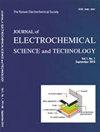Effect of Zinc Addition in Filler Metal on Sacrificial Anode Cathodic Protection of Fin-Tube Aluminum Heat Exchanger
IF 3
4区 工程技术
Q3 ELECTROCHEMISTRY
Journal of electrochemical science and technology
Pub Date : 2023-09-15
DOI:10.33961/jecst.2023.00374
引用次数: 0
Abstract
: This study investigated the tri-metallic galvanic coupling of different metals in the tubes, fillers, and fins of a heat exchanger. The goal was to prevent corrosion of the tubes using the fin as a sacrificial anode while ensuring that the filler metal has a more noble potential than the fin, to avoid detachment. The metals were arranged in descending order of corrosion potential, with the noblest potential assigned to the tube, followed by the filler metal and the fin. To address a reduction in protection current of the fin, the filler metal was modified by adding Zn to decrease its corrosion potential. However, increasing the Zn content of filler metal also increases its corrosion current. The study examined three different filler metals, considering their corrosion potential, and kinetics. The results suggest that a filler metal with 1.5 wt.% Zn addition is optimal for providing cathodic protection to the tube while reducing the reaction rate of the sacrificial anode.填充金属加锌对翅片管铝换热器牺牲阳极阴极保护的影响
本文章由计算机程序翻译,如有差异,请以英文原文为准。
求助全文
约1分钟内获得全文
求助全文
来源期刊

Journal of electrochemical science and technology
ELECTROCHEMISTRY-
CiteScore
6.30
自引率
8.10%
发文量
44
期刊介绍:
Covering fields:
- Batteries and Energy Storage
- Biological Electrochemistry
- Corrosion Science and Technology
- Electroanalytical Chemistry and Sensor Technology
- Electrocatalysis
- Electrochemical Capacitors & Supercapcitors
- Electrochemical Engineering
- Electrodeposition and Surface Treatment
- Environmental Science and Technology
- Fuel Cells
- Material Electrochemistry
- Molecular Electrochemistry and Organic Electrochemistry
- Physical Electrochemistry
- Solar Energy Conversion and Photoelectrochemistry
 求助内容:
求助内容: 应助结果提醒方式:
应助结果提醒方式:


